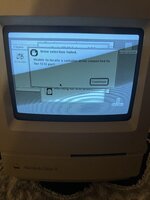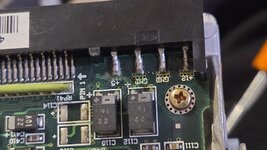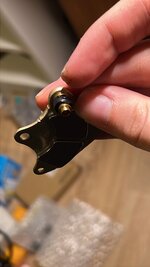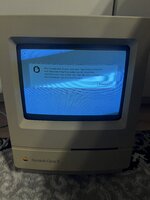I got a Macintosh Classic II with the checkerboard issue. After i recapped the logic board, everything worked fine. Shortly after that, I decided to recap the analog board and the floppy drive too. Most capacitors on the analog board were already leaking.
During the recapping of the floppy drive, I made a mistake. I soldered in 1 uF instead of 0.47 uF and 10 uF instead of 1 uF.
When turning the Mac on with the floppy drive connected, there’s only a rattling and squeaky noise coming from the floppy drive, nothing else. No fan, no chime, no screen, no HDD. It seems like something is shorted.
When i disconnect the floppy drive from the logic board, the computer turns on, the chime plays, the HDD begins to spin but after a few seconds the HDD turns off. It does not even try to read any data from the HDD. After 30 additional seconds the missing operating system symbol (blinking floppy) appears.
I also can’t boot from the ROM using Cmd + Option + x + o.
After that, I replaced the wrong capacitors in the floppy drive, but the issue still persists. Not turn on at all when floppy drive is connected and turning on but no boot from HDD when floppy is disconnected.
Have I fried the logic board?
During the recapping of the floppy drive, I made a mistake. I soldered in 1 uF instead of 0.47 uF and 10 uF instead of 1 uF.
When turning the Mac on with the floppy drive connected, there’s only a rattling and squeaky noise coming from the floppy drive, nothing else. No fan, no chime, no screen, no HDD. It seems like something is shorted.
When i disconnect the floppy drive from the logic board, the computer turns on, the chime plays, the HDD begins to spin but after a few seconds the HDD turns off. It does not even try to read any data from the HDD. After 30 additional seconds the missing operating system symbol (blinking floppy) appears.
I also can’t boot from the ROM using Cmd + Option + x + o.
After that, I replaced the wrong capacitors in the floppy drive, but the issue still persists. Not turn on at all when floppy drive is connected and turning on but no boot from HDD when floppy is disconnected.
Have I fried the logic board?







